#Plastic Recycling Conference
Explore tagged Tumblr posts
Text
Plastic Recycling Conferences in India: Innovation, EPR, and What Comes Next

India is shifting from awareness to enforcement in its battle with plastic waste. The conversations we’ve avoided for too long—on accountability, on infrastructure, on consumption—are now impossible to ignore. That’s what makes the Plastic Recycling Conference and Plastic EPR Conference, hosted by APIC, not just another industry gathering, but a necessary intervention.
The reality is harsh. Each year, India contributes a significant volume of plastic waste to the global total. A large portion of that never gets collected. Some of it gets incinerated. Some ends up clogging our rivers and streets. Some travels further, across oceans. And all of it—every last bit that isn’t recovered—reflects a broken system.
These conferences bring the people trying to fix that system into one space.
They come from different sides of the table—manufacturers, recyclers, policy advisors, municipal leaders, technology providers, compliance officers—but they have one thing in common: they know change has to happen now. Not in a decade. Not after another “pilot.” Now.
And that’s what makes this conference different. It’s not abstract. It’s practical. It’s grounded in what’s actually working on the ground—where segregating plastic at source isn’t easy, where recycling plants struggle with poor-quality feedstock, where EPR compliance still feels like a legal maze for most companies.
The Plastic EPR Conference is grounded in a simple but powerful idea: those who create plastic must take responsibility for its entire lifecycle. Producers can no longer afford to treat plastic as someone else’s problem once it leaves the warehouse. Under the new rules, companies are required to ensure a certain percentage of the plastic they use is either collected or recycled. That has turned sustainability from a CSR checkbox into a core operational challenge.
But it’s also opening new doors. Because in solving this challenge, many businesses are uncovering better systems, cleaner supply chains, and new collaborations that would have been unthinkable five years ago. The conference doesn’t just celebrate those changes—it questions them, tests them, and scales them.
Recycling has become a top priority, requiring urgent and concentrated efforts. Mechanical recycling in India remains deeply informal and underpowered. Chemical recycling offers a scalable pathway, but operational barriers still prevent it from going mainstream. Infrastructure is lacking. Demand for recycled plastic fluctuates wildly depending on raw material pricing. And yet, across cities and states, new models are emerging—quietly but consistently—proving that large-scale plastic recovery is possible.
These Plastic Recycling Conferences showcase those models—not just through presentations, but through genuine dialogue. What happened when a local recycler partnered with an FMCG brand to streamline collection? What legal loopholes are still slowing down circular packaging efforts? How are decentralized recovery systems succeeding where central facilities failed?
You won’t find scripted answers here. What you will find is raw insight. Honest discussion. People who are tired of cosmetic fixes and want deeper, systemic change.
And that’s why this conference matters beyond its agenda.
Because it’s not a media stunt. It’s not a greenwashed platform. It’s a mirror—and a map.
It forces participants to reflect on what isn’t working, while offering real routes forward. The discussions here don’t end with applause. They lead to pilots. MoUs. Internal shifts. Strategic partnerships. And sometimes even uncomfortable truths that push entire industries toward action.
One of the quiet strengths of the APIC-led Plastic Recycling Conference is that it doesn’t exist in isolation. It ties into India’s broader policy shift—toward mandatory reporting, circular economy frameworks, urban waste decentralization, and digital traceability. The EPR conversation, in particular, is getting sharper with each passing quarter, and this event becomes a checkpoint—where everyone recalibrates, realigns, and recommits.
For businesses, that means showing up is no longer optional. If your brand is selling plastic in any form, if your company is working in waste, or if your product roadmap intersects with sustainability targets, this is where you need to be. The conversations happening here shape what’s coming next—legally, operationally, and commercially.
For governments and municipalities, it’s a rare chance to hear what the private sector is struggling with. And for startups and recyclers, it’s a place to meet funders, partners, and future clients—all under one roof.
Most of all, though, this is a space for clarity.
In a sector full of contradictions, jargon, and confusion, the Plastic Recycling Conferences strip things down to what really matters: How do we recover more plastic, faster, and better? How do we make sure producers are part of the solution, not just the problem? And how do we scale systems that are fair—not just profitable?
As 2025 approaches and compliance deadlines get tighter, these questions aren’t theoretical anymore. They’re urgent. They’re commercial. They’re political. And this event is one of the only places in India right now where all those threads come together honestly.
So if you’re ready to move beyond the press release and into the work, visit https://apic.co.in/. Be in the room. Listen. Share. Disagree. Rethink. Learn. And walk away with something rare in the plastic debate: a reason to believe that change isn’t just necessary—it’s already underway.
0 notes
Text
morning patrols were something katsuki hated with a passion. as his break finally rolled around after a day as dead as ever, he slumped onto a random bench.
his peace lasted approximately five minutes until a group of fans came around, phones 'discreetly’ out and pointing towards him, though the flashlight gave away that they were recording. as the one scrambled to turn it off, another spoke up.
“dynamight? no way! i thought you'd be like– going crazy after seeing the rankings that dropped today.”
a record scratched in his head, his head tilted slightly as his eyebrows raised. “i don't think my patrolling is the problem.”
“yeah, it's probably your temper or something!” another one said, finger raised in the air. he didn't have time to be offended, as they then shoved a phone in his face, showing his ranking.
fifteen. not bad for how many people he'd cursed out recently. all he could do was scoff. “'s not horrible.”
“yeah! but she's totally beating you!”
his eyebrows scrunched inwards, his expression incredulous. “..she?”
“your wife! she's in the top ten!”
his eyes widened again, though this time, it was accompanied by a smirk on his lips. one that only grew alongside his pupils at the sight of you in your hero costume, a golden number eight right next to you.
“i guess she is.”
“you're not like.. upset?” they asked, not expecting at all this reaction from the guy who yelled just as much, if not more, at the people that he would actively save.
“nah, she deserves it.” a beat paused, and he looked up thoughtfully. until his fist slammed down onto the palm of his hand. “actually no, my wife deserves better. she's a damn good hero.”
he spaced out slightly, the words they spoke to him going through one ear and out the other as he though about the few missions he'd taken with you.
your mannerisms, the way your personality would bleed into your interactions with others. you had an undoubted professionalism about you. hiding the twitch of your eye with a smile, using your quirk masterfully even in your early career. your face, your body-
he closed his eyes, only after signing the shirts of those fans that had already left, and leaned against the uncomfortable recycled plastic of the bench.
you really did deserve it, and more. he'd have to tell you that..
well, he tried to. but he was beaten by his own words, seeing as the video those fans took of him praising you was trending pretty much everywhere.
as you laid on his chest and scrolled on your phone, a smile on your face as you showed him the screen.
“look, you went up a ranking. maybe you should talk about me more often, huh?”
he couldn't help but laugh. “be careful what you wish for. i could talk about you for hours.”
so now, you actually become an avoided topic for reporters. not unless they want the press conference to last an extra hour just on you.
tags: @k0z3me @darhinadadragon @maddietries @exoticrasin @lavendarstarz @hisonlyobsession @i-the-fluffo @cookielovesbook-akie @frosted-flakes @irenne-stans @lulumi1u @bakunis @twirlyphim @drawingforshitsandgiggles @babylambdietcoke @deimosjay
#i hope we see more of him in the extras#i know people were mad but as a krbk all i do is win actually#lilac's drabbles#lilac's late night talks ✧#bakugo x reader#katsuki bakugo x reader#bakugo#bakugo x y/n#bakugo katuski#bakugo x you#bakugo fluff#katsuki x you#bakugo drabble#mha x you#mha drabbles#mha#bnha#boku no hero academia#bnha bakugo katsuki#mha bakugou#bakugou x reader#bakugo imagine
3K notes
·
View notes
Text
California sued ExxonMobil Monday, alleging the oil giant deceived the public for half a century by promising that the plastics it produced would be recycled. Attorney General Rob Bonta’s office said that less than 5% of plastic is recycled into another plastic product in the U.S. even though the items are labeled as “recyclable.” As a result, landfills and oceans are filled with plastic waste, creating a global pollution crisis, while consumers diligently place plastic water bottles and other containers into recycling bins, the lawsuit alleges. “‘Buy as much as you want, no problem, it’ll be recycled,’ they say. Lies, and they aim to make us feel less guilty about our waste if we recycle it,” said Bonta, a Democrat, at a virtual news conference, where he was joined by representatives of environmental groups that filed a separate but similar lawsuit Monday, also in San Francisco County Superior Court. “The end goal is to drive people to buy, buy, buy and to drive ExxonMobil’s profits up, up, up,” he said. ExxonMobil, one of the world’s largest producers of plastics, blamed California for its flawed recycling system. “For decades, California officials have known their recycling system isn’t effective. They failed to act, and now they seek to blame others. Instead of suing us, they could have worked with us to fix the problem and keep plastic out of landfills,” Lauren Kight, spokesperson for ExxonMobil, said in an email. Dozens of U.S. municipalities as well as eight states and Washington, D.C., have sued oil and gas companies in recent years over their role in climate change, according to the Center for Climate Integrity. Those are still making their way through courts, including a lawsuit filed by California a year ago against some of the world’s largest oil and gas companies, claiming they deceived the public about the risks of fossil fuels.
87 notes
·
View notes
Text
A Little (bit of) Love
My piece for @tryzine !!
-
It starts deceptively simple: Cellbit and Roier are taking a walk together through the Favela at sunset, fresh coffees in their hands from Starbobby. Cellbit can’t stop staring at Roier. Roier can’t stop staring at Cellbit. Bobby is watching from above, probably rolling his eyes at how goofy Roier looks when he’s in love.
There are two creatures walking a step behind Cellbit and Roier that Cellbit is purposefully ignoring.
Roier’s shoe comes untied next to a recently-added flowerbed. Cellbit offers to tie it, Roier laughs and teases Cellbit, Cellbit hands Roier his coffee to hold as he crouches and takes Roier’s shoelaces in his hands.
Just barely visible through the gap between Roier’s legs, Pulgoier looks blankly up at the flowers. They’re taller than it is, but just barely.
?, the disgusting little thing, follows Pulgoier’s gaze. And then, horrifyingly, and entirely of its own accord, it reaches up and snaps a flower off at the base of its stem. It holds the flower out to Pulgoier, head ducked just slightly, almost bashfully; Pulgoier doesn’t smile, because it can’t, because it isn’t real, but it does take the flower.
Frozen in abject horror, Cellbit doesn’t react as Roier annoyedly taps at his head and asks what’s taking so long. Why is he just sitting there, what’s wrong?
And then Roier turns around and sees his Mini-Me holding the flower close to its chest and pressing a plastic kiss to ?’s cheek, and Roier gasps.
“Aww, look!” he coos, fingers tangling in Cellbit’s hair excitedly. “They’re in love!”
And Cellbit feels nothing.
-
Cellbit’s son is gone. So is a significant part of Cellbit’s heart, and yet he knows that he is still capable of feeling love. He’s alive, after all: he isn’t a religious man, but he likes to think that everything with a heart can feel love. Dogs love their owners. Lions love their mates. Crocodiles love the hunt. Parrots love to show off.
The Mini-Mes? Notably not alive. They aren’t real. They’re plastic and felt and yarn and whatever-the-fuck electronics the Federation shoved into their fake little bodies. Their nerves are made out of copper. Their veins are filled with self-recycling machine oil. Their hearts are combustion engines that run off of the items that their islander counterparts provide them daily.
Cellbit knows this. He’s cut his Mini-Me apart so many times that ? knows not to squirm on the dissection table. Every time he’s sewn ? back together, he’s made ? hold the roll of string so it doesn't roll away. He’s made ? bleed oil to the point that he once caught ? drinking gasoline when Cellbit’s back was turned.
The Mini-Mes don’t feel emotions. They can’t. They aren’t real. They’re creatures, if one could call an inhuman amalgamation of wires and eco-friendly microplastics a creature. It’s more apt to call them robots.
Monsters.
Cellbit knows that the MIni-Mes were created for war. He watched the video at that conference, he knows exactly what the little assholes were made for. Now that they’re stolen, their purpose has probably been shifted by the Federation from fighting to spying.
They can’t feel love. This much, Cellbit knows. They were created for battle, and now they’re just biding their time. Waiting.
The fact that ? seems to be in love with Pulgoier is an outlier that should not be considered. They’re both just mimicking their owners, that’s all. Which begs the question of exactly how adaptive the Mini-Mes are; they can change appearance at the drop of a hat, but behavior? They’ve been robotic up to this point, what changed?
Cellbit asks this to ? as ? sits in its cage staring at the oil-stained wall.
?, of course, doesn’t respond. That’s good, Cellbit doesn’t know what he’d do if the little bastard learned how to talk.
But, at the lack of a response, Cellbit inexplicably feels a sense of… God, is this bravery he’s feeling coming off of ?? Is that it? An attitude?
Cellbit’s eyes narrow, and he leans in closer to the cage with a sneer.
“Whatever you’re doing, I’m onto it,” he growls.
? just adjusts its goggles in response. Its hand briefly dips into the Fear Room’s light, exposing a thin black line drawn around ?’s left hand ring finger. A ring.
Cellbit is so surprised that he doesn’t even feel angry for a good moment.
But then ? looks up at him as if asking, “And what about it?”, and Cellbit finds himself standing and kicking the cage so hard that it falls over, sending ? toppling.
A ring. A goddamn ring.
A goddamn mockery, more like. It’s mocking him. The Federation is mocking him, he knows it. He fucking knows it.
(But… why?)
-
Pulgoier starts holding ?’s hand. ? keeps picking things off of the side of the road to give to Pulgoier, and Cellbit hates it.
Roier makes a little shoebox bed for them that he puts under his and Cellbit’s own bed. Instead of powering off for the day in a corner of the room, ? and Pulgoier go there at night, and Cellbit hates it.
? and Pulgoier sit across from each other on the floor when their owners have their meals. Sometimes they pretend to eat, usually pretending to feed each other, and Cellbit hates it.
Richarlyson would have killed them by now. Cellbit wishes he was here to do so, but.
But.
-
But it’s well past midnight, and Cellbit can’t sleep. This isn’t anything too unusual; he learned how to live off minimal sleep back during the War, for better or for worse.
But Roier can’t sleep, which means that he’s somewhere in the castle, which means that Cellbit is somewhere in the castle because there’s no way in Hell he’s letting his depressed and sleep-deprived husband wander around mourning.
Tonight’s ‘somewhere’ is the garden, and Cellbit has Roier in his arms as they sway back and forth to the music playing softly on Roier’s communicator. (The Federation is shitty for so many reasons, but at least it’s providing the island with Spotify Premium free-of-charge.)
The song is unimportant. So are the two little freaks of nature watching from beneath a rosebush. So are the Federation’s hidden cameras, and Bad somewhere downstairs trying to carry Cellbit’s dining table out the door, and the itching bloodlust in the back of Cellbit’s brain.
What is important is Roier, and so Cellbit focuses all his attention on him.
He’s tired, clearly so: his hair is more of a mess than usual, his clothes are rumpled and wrinkled, his shoes are untied, his bandana is lost somewhere in the bedroom, his lips are chapped, and the circles under his eyes are dark enough to rival Cellbit’s.
Cellbit doesn’t think he’s ever seen a more beautiful man in his life.
He says as much, words ghosting across Roier’s pale lips.
Roier smiles weakly, and he murmurs a quiet, “No, you.”
The song changes to something a bit quicker. They both ignore the change in tempo and decide to follow each other’s, instead.
Cellbit’s arms tighten around Roier. He pulls him closer, nose burying itself in the side of Roier’s neck and breathing in his scent and internalizing it, filing it away in the little cabinet in his brain labeled ‘Roier’.
“You stink,” he grumbles.
“Yeah, because you’re all over me,” Roier responds. He lightly pinches Cellbit’s side. “I know what we’re doing when we get back inside.”
Cellbit whines, sagging in Roier’s arms. He loves his husband, but he does not love showering with him; Roier takes so long under the water that it’s running cold by the time it’s Cellbit’s turn, and his shampoo smells so strongly that it makes Cellbit have an asthma attack.
Cellbit doesn’t even have asthma!
What Cellbit does have is an unfortunately-acute sense of hearing. It’s a blessing at times, and it’s a curse.
His eyebrow twitches in annoyance as he hears the absolute faintest of sounds: the crunching of grass beneath clumsy feet, and the overworking of machinery as it tries to figure out how to laugh.
At the same time, Roier gasps, “Mira, mira!”
But Cellbit doesn’t look. Why should he? He’s having a good time. He doesn’t need some… some… some things ruining it.
“Ay,” Roier insists, poking Cellbit between his ribs once. “Gatinho, mira.”
Another poke. “Mira.”
Another poke. “Cellbit.”
(Poke.) “Cellbo.”
Cellbit’s eyes squeeze shut. He presses a kiss to the crook of Roier’s neck to try and appease him, but Roier just pokes him again. With determination.
“Stop ignoring me!” he huffs. “Unless… you hate me? You want a divorce?”
At that, Cellbit’s head snaps up in a panic.
“Não!” he shouts. Why would Roier ever…
Lips twitching into a semblance of a smile, Roier grabs Cellbit’s face with one hand- squeezing his cheeks together and making him feel a bit like a fish- and turns it to the side.
…right. If there’s one thing Roier is, it’s a fucking asshole. (And a handsome one at that.)
Cellbit’s shoulders sag in relief, but said relief quickly melts back into annoyance as he’s forced to look at the Mini-Mes and their… well. It isn’t dancing, that’s for certain.
Pulgoier has taken the lead, just like Roier has. It’s holding ?’s little hands and rocking from side-to-side: left, right. Left, right. Left, right. It doesn’t move from its spot other than a small amount of shuffling as it tries pulling at ?’s hands in an attempt to get it to actually move.
? is still. It’s staring directly into Pulgoier’s beady little eyes, absolutely frozen. If it could blush, Cellbit is sure that it would be doing so.
Cellbit inadvertently copies it, stiffening against Roier’s body and stopping any and all movements. He doesn’t mean to- he wants to keep dancing, to keep ignoring the Mini-Mes and their bastardized attempt at “romance”, but…
“Look,” Roier quietly says, sounding almost awed.
He lets go of Cellbit’s face so he can press his cheek against Cellbit’s.
Cellbit feels Roier’s jaw work against his as he concludes, “It’s us.”
Because… it is. It is, somehow, in such a fundamental way that Cellbit can’t really identify it as anything but Cellbit-And-Roier.
“Oh,” says Cellbit, voice hardly above a whisper.
He watches as Pulgoier tugs on ?’s arms, and as ?’s legs start to shake under it.
Cellbit doesn’t actually remember a lot of his wedding reception; between the explosions and the alcohol, it’s all just a lot of blurry faces and the feeling of Roier-Roier-Roier-Roier-Roier.
What he does remember is being ushered into the center of the dance floor along with Roier and freezing. The world faded from around him, and all he could think about was Roier’s smile as he took Cellbit into his arms; Roier’s warm hands on his body; Roier’s alcohol-laced breath across his face. His body was a stranger.
He remembers thinking, ‘Shit. I don’t know how to dance.’ Because he didn’t, and he still doesn’t, because he never had a chance to learn how. It just never came up in his life, and then, suddenly, he was supposed to dance. At his wedding. In front of the entire island. And everyone he knew.
And he remembers the way Roier’s face softened as he picked up on Cellbit’s anxiety. His hands slid from Cellbit’s back, up to his shoulders, down the lengths of his arms, and to his hands. He tangled their fingers together, took a step back, and winked.
Pulgoier physically can’t wink, but it otherwise does exactly what Roier did all those months ago: it takes a step back, and it just starts spinning.
? can’t shout like Cellbit did back then, but it otherwise does what he did all those months ago: it gets pulled along, forced to spin along with its partner, stumbling over its own feet and flailing about like a doll caught in the wind.
“I can’t fucking believe this,” Cellbit mutters.
“I can,” Roier replies. “He’s your Mini-Me, of course he can’t dance for shit.”
He yelps out a laugh as Cellbit indignantly steps on his foot.
Roier’s right, though; Cellbit can’t dance for shit. And neither can ?, being Cellbit’s shitty little clone.
The night of the wedding, it took Cellbit a good solid minute to get his feet back under him. He felt himself smiling, and, maybe it was the wine in his system, but he found himself tugging Roier in a spin in the opposite direction. He was dizzy as Hell, but it made Roier laugh when he did it, so he just… kept doing it. Eventually, the spin led into a proper attempt at a slow dance that failed so miserably that the two of them gave up and jumped onto the stage for another round of karaoke.
Tonight, ? picks up on things a bit quicker than Cellbit had. It stabilizes, nods to itself, and starts pulling Pulgoier into its own spin. Almost immediately, they’re attempting a proper waltz, and Cellbit…
Cellbit doesn’t get it.
At first, Cellbit wasn’t sure what the end goal of the Mini-Mes was. Then, he realized that they’re little soldiers. Robotic supersoldiers capable of self-multiplication and growth, literal war machines.
But then… why do they look like the islanders? Why does Pulgoier have the same dark circles as Roier? Why does ? have the same scar across its chest that Cellbit does? What’s the point? The Federation doesn’t do anything without a purpose, so why do the Mini-Mes have to look like their owners if they’re meant to grow up and kill them?
Why can they dance?
“What’s the point?” he murmurs. Roier hums in acknowledgement, and Cellbit takes that as a sign to continue: “Of copying us?”
“Because we’re sexy,” Roier responds.
Cellbit rolls his eyes. “True. But, think about it, what purpose does any of…” (He waves his hand in the MIni-Mes’ general direction.) “...this serve?”
“I don’t know, but… look at them.”
Cellbit looks. He doesn’t understand. Something uncomfortable rises in his throat.
? twirls Pulgoier, leading it into a dip. Pulgoier raises its head and presses its painted mouth against ?’s.
Chest clenching, Cellbit tries to tear his eyes away, but he just… can’t. He can’t. Not when they’re right there, not when they’re-
“You think they’re learning from us, right?” Roier asks. “So… maybe they aren’t learning how to kill us. Maybe they’re learning to be us.”
Cellbit gives him a flat look. “Isn’t that just as bad?”
Roier shrugs, still watching the little monsters.
“Maybe,” he replies. “I’m not a scientist. But… isn’t it kinda crazy that we taught robots how to love?”
But robots can’t love. They can’t. But.
Roier’s arms tighten around Cellbit’s body. His smile is just as forced as it has been since the eggs all vanished, but his eyes are surprisingly soft as he watches the Mini-Mes tumble into the grass from the force of their silent, impossible laughter.
“They’re just copying us,” Cellbit weakly says. “It isn’t actually real.”
“Maybe,” Roier hums. One hand travels up to cup the back of Cellbit’s head, gently pulling it against his chest. Cellbit listens to Roier’s heartbeat and wills his own heart to match its pace.
“Or,” he continues, “maybe it is. We found our reasons. Maybe they found theirs.”
They watch the Mini-Mes, and the Mini-Mes don’t notice.
The song changes, and Roier starts leading Cellbit into another dance.
Cellbit’s eyes slip shut, and he lets himself get swept away by Roier’s movements.
(Bagi would call Cellbit a monster, but Cellbit found love in the end. So maybe, just maybe, ? could have done the same.)
#spiderbit#guapoduo#qsmp#a.d.'s fics i suppose#a.d.'s fics i suppose.#i'm actually really proud of this one#i never write canon but. come on. it's them!#and the other them!
98 notes
·
View notes
Text
Excerpt from this story from Grist:
What was supposed to be the final round of United Nations negotiations for a global plastics treaty ended without an agreement on Sunday, as delegates failed to reconcile opposing views on whether to impose a cap on plastic production.
Another negotiating session — dubbed INC-5.2 after this week’s INC-5 — will be held in 2025, but it’s unclear how countries will make further progress without a change in the treaty’s consensus-based decision-making process. As it stands, any delegation can essentially veto a proposal they don’t like, even if they’re opposed by most of the rest of the world.
“If it wasn’t for Saudi and Russia we would have reached an agreement here,” one European negotiator told the Financial Times. Those two countries, along with other oil producers like Iran and Kuwait, want the plastics treaty to leave production untouched and focus only on downstream measures: boosting the plastics recycling rate, for example, and cleaning up existing plastic pollution.
Kuwait’s delegation said on Sunday that “we are not here to end plastic itself … but plastic pollution.” That’s the position the plastic industry is taking, as well: Chris Jahn, council secretary for a petrochemical industry consortium called the International Council of Chemical Associations, said it’s ���crucial” for the treaty to focus on plastic pollution alone. “With 2.7 billion people globally lacking access to waste collection systems, solutions must prioritize addressing this gap,” he said in a statement.
Dozens of countries — supported by scientists and environmental groups — say that approach is futile while the plastics industry plans to dramatically increase plastic production. “You can talk about waste management all you want, but this is not the silver bullet,” one of the European Union’s delegates said last week. “Mopping the floor when the tap is open is useless.”
Christina Dixon, oceans campaign leader for the nonprofit Environmental Investigation Agency, attended INC-5 and told Grist the conference made it clear that “consensus isn’t working.” She said countries seem to be recognizing this too, in light of INC-5’s shortcomings and the low probability of finding unanimity on the treaty’s most critical issues.
Technically, the treaty could move forward without Saudi Arabia, Russia, and their allies, either continuing under the U.N. framework or — a more radical scenario — in a new forum led by a breakaway alliance of countries. The latter is unlikely given the time and energy countries have invested in the U.N. system, and because they still value the baseline mandate they agreed to two years ago: to “end plastic pollution” by addressing the “full life cycle of plastics.” But a smaller group of signatories could still make a global impact by using import tariffs and other trade policies to indirectly influence plastic production in non-signatory nations.
34 notes
·
View notes
Text
Carbon dioxide (CO?) should be viewed not as a climate threat but as a valuable renewable resource. At two climate-related conferences, experts like Jacques Amouroux argued that captured CO? can be repurposed for energy storage, manufacturing plastics, and enhancing fossil fuel extraction. Amouroux emphasized that CO? is fundamental to life—supporting food production, materials like wood and cellulose, and industrial processes—and should be recycled rather than treated as waste. Beware of the climate cult, they want to wreck the planet with your money.
Science or a lack thereof? UK’s £3 million Ocean CO2 Removal Project draws skepticism and scrutiny
The UK government has invested £3 million in SeaCURE, a pilot project aiming to extract carbon dioxide (CO2) from seawater and bury it underground—a controversial approach to combating climate change. Backed by researchers from Plymouth Marine Laboratory and the University of Exeter, the initiative has sparked criticism for its negligible impact, questionable scalability, and potential ecological risks. Meanwhile, rising sea temperatures around the UK complicate the science behind the project, raising doubts about its feasibility and the broader priorities of climate funding.
SeaCURE’s system involves pumping seawater from the English Channel, stripping it of CO2, and returning it to the ocean to absorb more atmospheric carbon. The project claims it could eventually remove 14 billion tonnes of CO2 annually—if scaled to process 1% of the world’s surface seawater using renewable energy. However, critics point out that even at full capacity, this would offset emissions equivalent to fewer than 219 transatlantic flights per year—a drop in the bucket compared to global aviation’s daily output.
7 notes
·
View notes
Text
130 words written today. I know where this scene is going, I'm just...exhausted. Today's been one of my traditional bad Tuesdays (for some reason Tuesdays are historically bad for me), which is not ideal as I've got course prep I need to do since it would be nice to have like. syllabi. this week. I've got a burgeoning Problem coming up that is fully and completely out of my hands and I got a conference rejection today. (Which is probably for the best, as I've already got three conferences scheduled for spring anyway, but it's one I really wanted to go to and can't unless I'm presenting, since it's international and thus expensive. But also I have to go to Japan in July so having two international trips back to back would have sucked.) I need to get my life together so I feel less hysterical this spring than I did in fall, where I was constantly playing catch-up. I'm not even unpacked. I have an entire room in my apartment that is just boxes and plastic-wrapped furniture. I have broken-down boxes in my apartment from August because I can't take them to the recycling center without a car and keep forgetting to ask someone if they'll help. also, it's cold.
9 notes
·
View notes
Text
Our adorable little bug Khajida is undoubtedly an excellent tailor who was able to design a casual outfit for Jaime (possibly in an extremely fast time). He is a considerate and efficient design and production all-in-one machine
I think he may have developed his hobby of designing clothes and using environmentally friendly materials to make them, such as using Jaime... (you know). Since he can use these (you know), can he use household waste or other environmentally harmful materials that need to be recycled to make his clothes?
Imagine they go to the community to pick up garbage, to the beach to pick up garbage, and after the meeting, they casually bring back empty plastic bottles from the conference room. When Jaime was asleep, Khaji da began to fully unleash his creativity, and when Jaime woke up, he saw new clothes all over the floor.
Then they picked a day off to sell clothes on the street, and friends came to support them.(I believe that with Khaji's abilities, he will soon be able to compete with advanced fashion designers
But none of the above is what I really want to say, it's just to cover up my dirty real thoughts. I'm curious why I didn't see anyone say this
Khaji da, Wearing new clothes for Jaime after disarming... So why, it's not a costume for fun
Why not? One day, Jaime reintegrated into the crowd after cracking down on crime, and everyone looked at him because Khajida gave him a bunny girl costume. Or Jaime could go on a date with someone and find himself dressed as a maid, wearing cat ears and a collar when he lands. When he was half exhausted and climbed onto the bed, he woke up to find himself wearing a real lingerie. As for superhero uniforms? It will be much more exciting than the female characters portrayed by cartoonists with male gaze. I mean, jaime Reyes will wear a more exciting erotic costume than the black canary to fight crime.(which reminds me of klk)
"If I can protect my family, even if I'm completely naked, it's okay!"
And these thoughts make me feel like a criminal👉👈
Anyway, we should understand that this scarab is actually the most promising s ■■ costume designer ever, and he will add unexpected surprises to Jaime's life. (Jaime's mother won't allow it, no matter what.
Although I still have a lot to say about this idea, let's stop at it(°ー°〃)
#I am a serious person with a serious study life and a serious translator#but without any serious thoughts#khaji da#jaime reyes#blue beetle#Just some small ideas 👉👈#Oh#they will be featured in those magazines
9 notes
·
View notes
Text
Rethinking Waste: The Role of Plastic Recycling Seminars and Conferences in a Greener Future
The global conversation around environmental preservation is evolving, and a significant part of that dialogue now revolves around plastic waste management. As societies move toward sustainability, the importance of innovation in recycling has taken center stage. One of the most effective ways this innovation is shared and scaled is through industry-focused gatherings like the Plastic Recycling Seminar and Plastic Recycling Conference events happening around the world. These platforms are not only information-rich but also instrumental in shaping the future of waste handling, policy making, and technological evolution.
In this landscape, APIC has emerged as a trailblazer, continually fostering dialogue and practical action in the realm of waste management. Known for hosting globally recognized events, APIC creates platforms where decision-makers, industry professionals, scientists, and innovators come together to exchange knowledge and build collaborative solutions. With a mission focused on sustainability and strategic impact, APIC ensures that every event, whether local or international, offers participants real-world takeaways and meaningful networking opportunities. You can explore their initiatives and upcoming conferences by visiting our website.
What makes these conferences truly special is their dynamic and inclusive nature. Rather than being limited to technical presentations, they serve as melting pots of ideas, uniting voices from across the globe who share a common goal: transforming how we think about plastic waste. Whether it’s a researcher unveiling a new recycling process or a policymaker discussing upcoming regulations, every voice plays a part in building a circular economy. The Plastic Recycling Seminar has increasingly become a space where such meaningful dialogue translates into actionable strategies for industries and governments alike.
The value of these events goes far beyond intellectual discourse. They provide a snapshot of global progress, highlight what’s working, and critically examine what still needs to be done. Attendees leave with more than just insights—they return to their organizations equipped with solutions and partnerships that can create tangible change. That’s why APIC’s events stand out: they merge high-level strategy with hands-on innovation, offering a comprehensive view of where the recycling industry is headed. Their deep-rooted commitment to addressing waste at every level—from urban hubs to remote regions—ensures that progress isn’t just theoretical, but actually applied in the real world.
The power of a Plastic Recycling Conferences lies in its ability to adapt to new challenges. As consumer demand for sustainable products increases, businesses are under pressure to deliver eco-friendly alternatives without sacrificing quality or profitability. Conferences hosted by APIC offer business leaders the guidance they need to meet this demand through updated practices, eco-conscious product designs, and smarter logistics. At the same time, entrepreneurs and startups find encouragement and resources to pursue their own green innovations, often forming partnerships that accelerate growth and impact.
Another hallmark of these conferences is their role in empowering local communities. By involving stakeholders from all levels—municipal leaders, educators, environmental groups—APIC ensures that recycling efforts are rooted in local contexts. These localized approaches create opportunities for job creation, education, and infrastructure development that are both environmentally and economically beneficial. It’s not just about large-scale policy; it’s about implementing those policies in ways that improve lives and protect ecosystems.
While the world continues to grapple with the mounting pressures of plastic pollution, initiatives like the Plastic Recycling Seminar remain essential. They spotlight the collective urgency of our global plastic problem, but more importantly, they show the world that progress is possible. Through shared knowledge, open dialogue, and a willingness to adapt, industries are learning to see waste not as a problem, but as a resource. This shift in mindset, fueled by continued education and innovation, is the key to long-term change.
APIC plays a critical role in this transformation, not only as a host but as a thought leader. By continuously evolving their content, speaker lineups, and engagement formats, they ensure that each Plastic Recycling Conference remains relevant, practical, and forward-thinking. Attendees are never passive observers—they are active participants in shaping the policies, products, and systems that will drive the next era of recycling.
Whether you're a corporate leader seeking sustainable solutions, a policymaker shaping regulations, or simply someone who wants to learn more about creating impact, APIC offers a platform where your journey can begin. The future of plastic recycling depends on how well we work together today, and these events are a powerful reminder that the solutions to our biggest challenges often start with a single, shared conversation.
0 notes
Text
Uses and Functions of Non Woven Bag Printing Machine
Introduction
In recent years, the global movement towards sustainability and eco-consciousness has spurred a significant shift in consumer behavior and industrial practices. As businesses strive to reduce their environmental footprint, the demand for eco-friendly alternatives to traditional plastic bags has surged. Enter non-woven bags — lightweight, durable, and reusable alternatives that have gained widespread popularity. At the heart of this eco-friendly revolution lies the non-woven bag printing machine, a marvel of modern engineering that enables the mass production of customized, environmentally responsible bags. Let’s delve deeper into the efficiency and functionality of these innovative machines.

The Rise of Non-Woven Bags
Non-woven bags are crafted from synthetic or natural fibers bonded together through a mechanical, thermal, or chemical process — without the need for weaving. This manufacturing method results in bags that are strong, tear-resistant, and capable of carrying heavy loads. Moreover, non-woven bags are reusable, recyclable, and biodegradable, making them a sustainable choice for environmentally conscious consumers and businesses alike.
Advantages of Non-Woven Bag Printing Machines
Customization: Non-woven bag printing machines offer unparalleled flexibility, allowing businesses to create bespoke designs and branding solutions tailored to their unique requirements.
Speed and Efficiency: With rapid printing capabilities and automated processes, these machines enable high-volume production without compromising on quality or accuracy.
Cost-Effectiveness: By streamlining production workflows and minimizing material waste, non-woven bag printing machines help businesses optimize their operational costs and maximize profitability.
Environmental Sustainability: By facilitating the production of reusable and recyclable non-woven bags, these machines support sustainability initiatives and contribute to the reduction of plastic waste.
Non-woven bag printing machines are the unsung heroes of modern manufacturing, offering a multitude of uses and functions in various industries.
Functions of Non Woven Bag Printing Machine
Customization Made Easy
These machines empower businesses to personalize non-woven bags with logos, designs, and messages, enhancing brand visibility and communication.
Promotional Powerhouses
Ideal for creating branded merchandise, custom-printed non-woven bags serve as effective promotional tools at trade shows, events, and marketing campaigns.
Sustainable Packaging Solutions
In retail, these machines help elevate packaging by customizing non-woven bags with brand aesthetics, product showcases, and eco-friendly messaging.
Memorable Event Souvenirs
From conferences to weddings, custom-printed non-woven bags make practical and memorable giveaways, leaving a lasting impression on attendees.
Environmental Advocacy
By enabling the production of reusable and recyclable bags, these machines contribute to environmental sustainability efforts, promoting eco-conscious consumption.
In essence, non-woven bag printing machines are more than just production tools — they’re enablers of creativity, sustainability, and brand empowerment in a rapidly evolving world.
Best Non Woven Bag Printing Machine Companies in India
If you are looking for a Best Non Woven Bag Printing Machine in India, then look no further than Decent Print Line. Decent prinline is a leading manufacturer and supplier of non woven bag printing machine in India.
For more details, please contact us!
Website — https://www.decentprintline.com/
Contact — +91–9911433180
Email — [email protected]
Address — Plot №4, Gali №1, Rao Colony, Sihi Gate, Faridabad, Ballabgarh — 121004, Haryana, India
#Non Woven Bag Printing Machine#Non Woven Bag Printing Machine manufacturer#Non Woven Bag Printing Machine supplier#Non Woven Bag Printing Machine manufacturer in India#Non Woven Bag Printing Machine supplier in India#Decent printline
2 notes
·
View notes
Text
10 Stars Who Flew The Flag For Sustainable Fashion In 2021
2021 has seen the fashion industry ramping up its efforts to reduce its impact on the planet. But it’s not just brands that are taking action, with a number of celebrities, too, flying the flag for sustainable fashion this year. Whether by wearing vintage or opting for an eco-minded designer, A-listers have a powerful role to play in influencing our shopping habits, and making conscious fashion the norm.
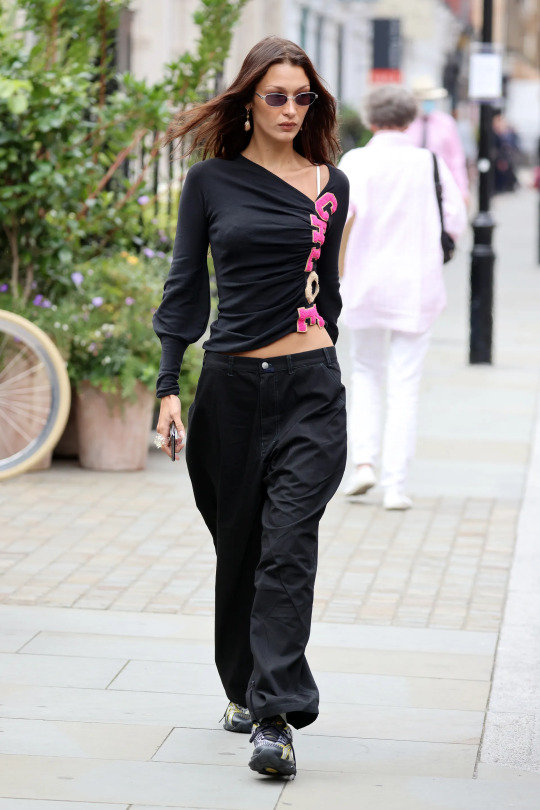
Bella Hadid
Bella Hadid is well-known for her love of vintage, with her penchant for archival Jean Paul Gaultier, Comme des Garçons and Stella McCartney-era Chloé only continuing to grow this year. She’s also added some more unexpected brands into the mix, including a micro skirt from Noughties favourite Abercrombie & Fitch.
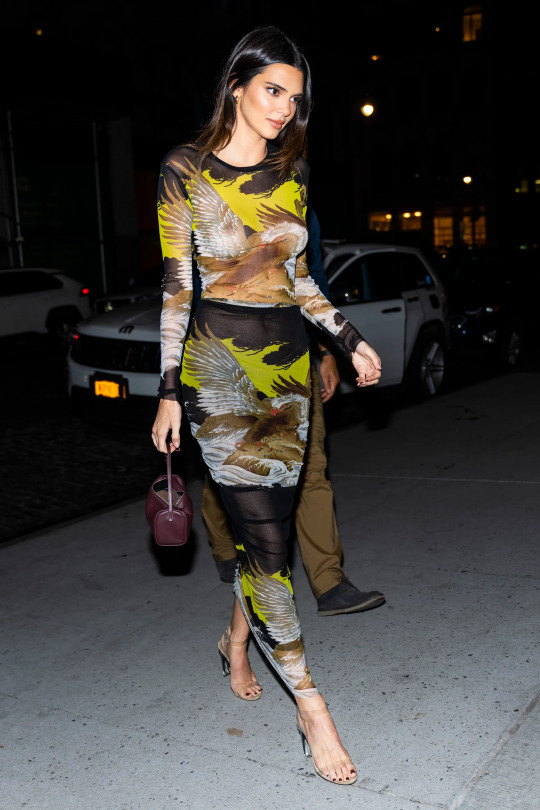
Kendall Jenner
Another JPG obsessive, Kendall Jenner has given us some of our favourite vintage looks of the year, including this printed sheer number by the French brand. The model is also a fan of eco-conscious brand Havre Studio, which restores and refits vintage men’s suits found at flea markets in Mexico City.
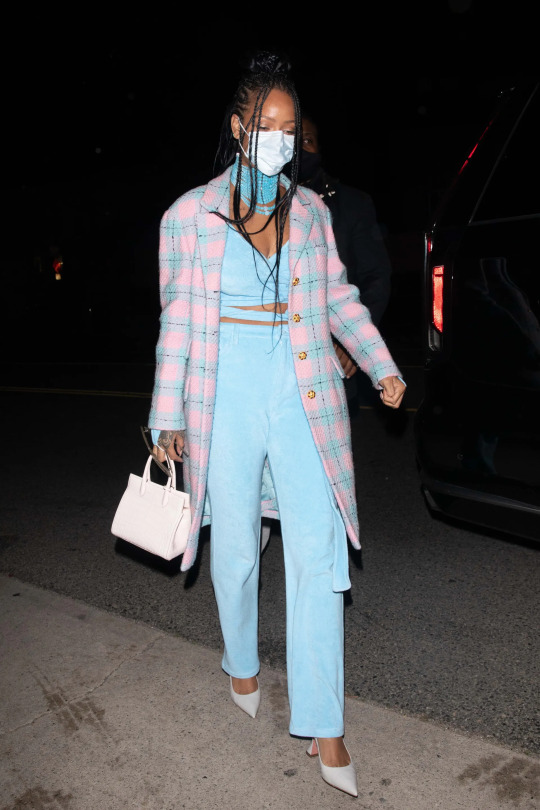
Rihanna
From Chanel to Dior by John Galliano, Rihanna’s shown off a series of envy-inducing vintage pieces in 2021. She’s also continued to champion New York-born and London-based designer Conner Ives, who repurposes vintage jerseys and silk scarves as part of his approach.
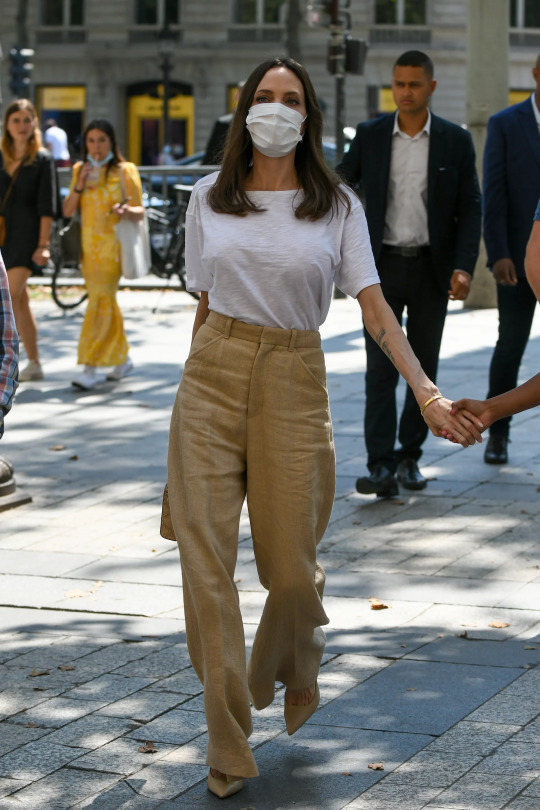
Angelina Jolie
Angelina Jolie is known for her environmental work, so it’s no surprise that the actor and activist has taken a conscious approach to her wardrobe this year. For a trip to Paris in July, she opted for looks from both Gabriela Hearst and Chloé, the latter of which gained B-Corp status this year. Later on, her children appeared on the red carpet wearing past looks from her wardrobe, including her 2014 Oscars gown.

Emma Watson
Another star known for her environmental activism, Emma Watson has also championed a number of eco-minded brands this year. The actor wore an upcycled Harris Reed dress to the Earthshot Prize ceremony, while opting for an Emilia Wickstead look made using recycled yarn to meet Al Gore. Watson also later chose a full-look by Scandi upcycling brand Rave Review during Cop26, the United Nations climate conference, in November.

Zendaya
Zendaya has delivered some of her best looks to date in 2021, including a series of vintage pieces – ranging from ’90s Versace to Noughties Roberto Cavalli. With the British Vogue October issue cover star revealing she’s creating an archive with stylist Law Roach, it just goes to show how a slice of fashion history can make a real statement on the red carpet.
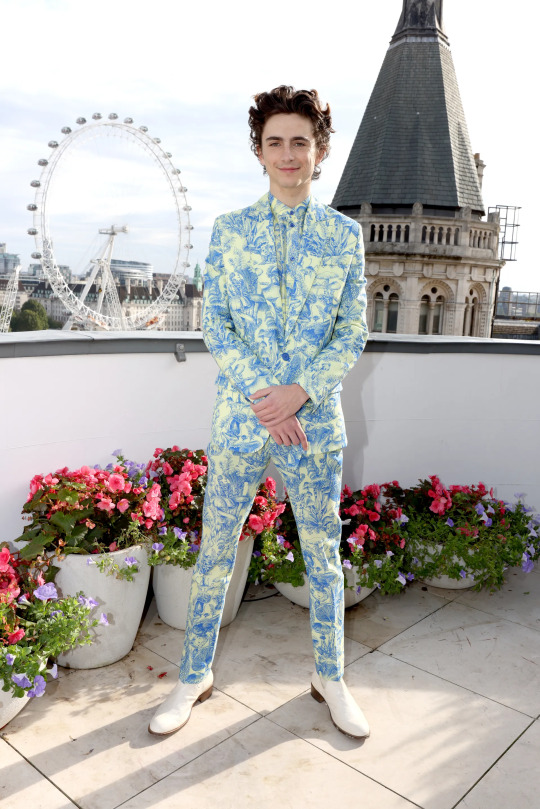
Timothée ChalametIt’s no secret that Timothée Chalamet sets the internet alight with every look he steps out in – which is why it’s great news that he’s been championing sustainably-focused brands. They include Stella McCartney, a favourite of his, as well as pieces from Prada’s Re-Nylon range – made from discarded fishing nets and other plastic waste.
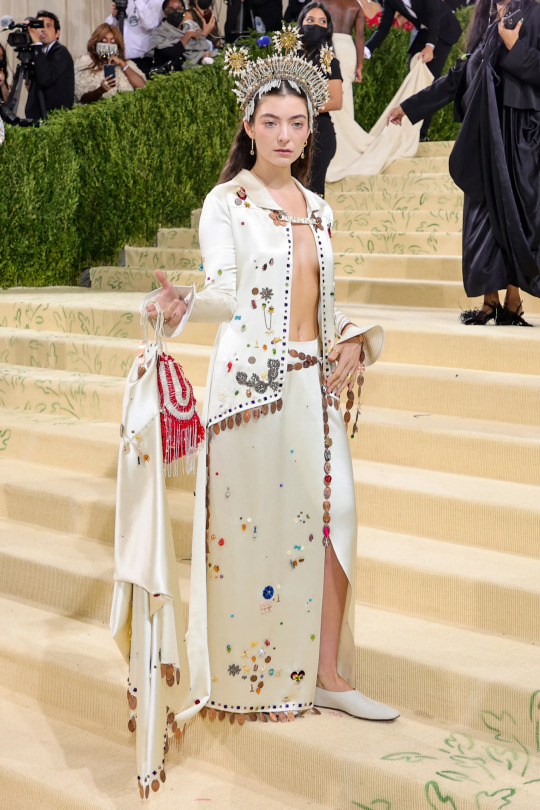
Lorde
Lorde showed her commitment to sustainable fashion by wearing not one but two eco-minded looks on the night of the Met Gala. First came the embellished separates by Emily Bode, which celebrated craft and featured charms, beads and pennies dating back to the 1890s. Then, there was the after-party dress by Collina Strada (a brand that she also chose for her “Solar Power” video).
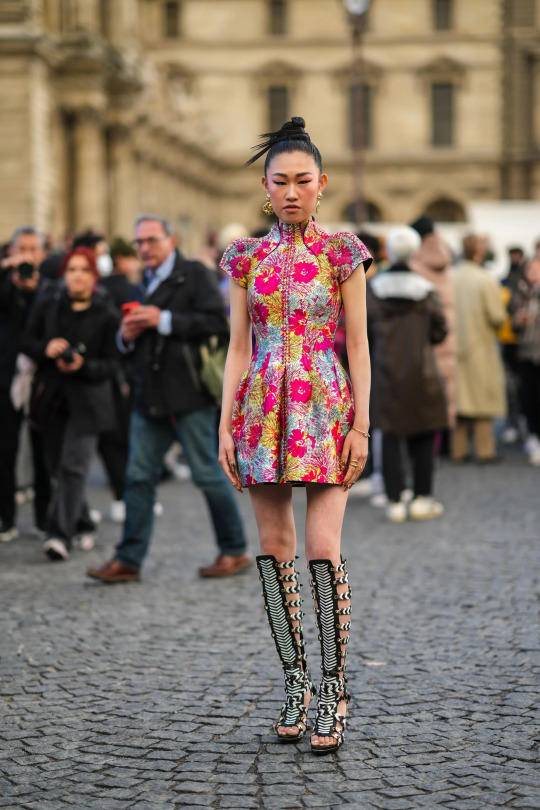
Jaime XieBling Empire star Jaime Xie made a point of wearing vintage during fashion month, including an instantly-recognisable sculpted dress from Balenciaga spring/summer 2008, a printed dress from Versace’s menswear spring/summer 2005 collection, and a Dior spring/summer 2004 silk dress, from when the house was under the helm of John Galliano.

The Duchess Of Cambridge
Arguably the most famous repeat-wearer out there, the Duchess of Cambridge chose to rewear two Jenny Packham gowns (including one that was a decade old) for her appearances at the Earthshot Award ceremony and Royal Variety Show this year. Away from the red carpet, Kate also championed sustainability, opting for a recycled vest from Ganni during Cop26, and a top-handle bag from British brand Tusting earlier on in the year.
3 notes
·
View notes
Text
More info:
These fish sculptures made from plastic bottles were apparently an officially-sanctioned part of the UN Conference on Sustainable Development (Rio+20) that took place in Brazil [in 2012]. The artist who designed the installation remains somewhat of an internet mystery. While most of the reaction has been very positive…
… there was some dissenting opinion about the worthiness of this project. The breakdown of the glue-gunned bottle sculptures that occurred later in the week was part of a much harsher, contrasting critique by Kari Koch of the Portland Occupier:
“This was a demonstration of how clever marketing and a pretty face can create lovely images that briefly cover the destruction of industry, but ultimately falls apart and leaves trash everywhere.
“The water bottles are falling all over the beach and the bay at Botafogo Beach is wretched with pollutants and sewage.
“The Green Economy wants us to think that our world can be preserved and sustained by continuing to create giant artifacts, plastic constructions, and endless growth. The truth is that we cannot continue to have endless growth. We cannot sustain our world and our lives by producing more and allowing corporate interests to buy off their pollution by owning a forest or by creating public art.
“Instead of building fish, corporations need to clean up their messes, leave the public areas to the people who know how to protect them, and ultimately those corporations (and the plastic bottles they create) need to be dismantled.
“The same system that created this mess cannot possibly understand how to build an alternative that sustains our world, our communities, and our lives.
“This fish of Botafogo will soon be nothing more than plastic particles in trash bags…”
Corporate Fish In A Wretched Bay — Report From Rio+20
Since the artist who created the sculptures is not known, it’s difficult to confirm whether Koch is correct in implying corporate sponsorship.
But there was another high-profile artwork at Rio+20 that also used “recycled” bottles which was sponsored in part by Coca-Cola…

Vik Muniz’s Landscape Project for Rio+20 was “partially underwritten by corporate sponsors including Coca Cola and Rio-based newspaper O Globo.”
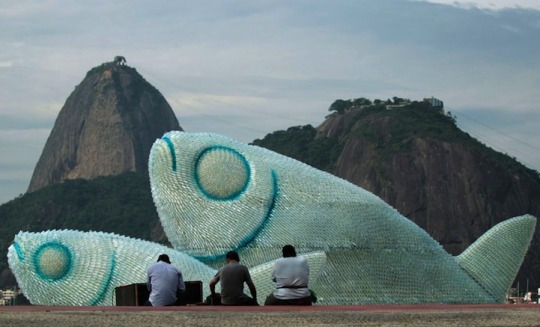
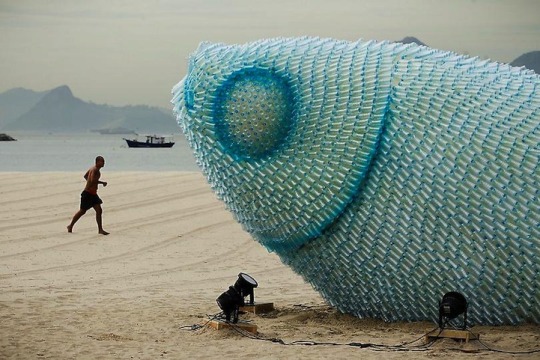
Glowing Giant Fish Made of Discarded Plastic Bottles, Playa de Botafogo, Rio de Janeiro, Brasil
39K notes
·
View notes
Text
Top Old Furniture Scrap Buyers and Office Scrap Buyers in Hyderabad
In a city like Hyderabad, where businesses and residential areas are constantly evolving, the demand for old furniture scrap buyers in Hyderabad and office scrap buyers in Hyderabad is on the rise. Whether you are decluttering your home or renovating your office space, these buyers provide an easy and environmentally responsible way to dispose of unwanted furniture, office equipment, and scrap materials. Let’s explore the world of scrap buyers in Hyderabad, with a special focus on furniture and office scrap.
What Are Scrap Buyers?
Scrap buyers are individuals or businesses that purchase old or unused materials with value for the purpose of recycling, reuse, or resale. These buyers usually focus on various types of materials such as metal, wood, paper, plastics, and more. In cities like Hyderabad, scrap buyers play a significant role in reducing waste and contributing to the circular economy.
Old Furniture Scrap Buyers in Hyderabad
Old Furniture Scrap Buyers in Hyderabad offer a valuable service to individuals, offices, and businesses looking to dispose of old or damaged furniture. Instead of simply throwing away furniture that no longer serves its purpose, it can be sold to scrap buyers who will either recycle the materials or refurbish the furniture for reuse.
Common types of furniture that can be sold as scrap include:
1. Wooden Furniture: Old wooden tables, chairs, wardrobes, and cabinets are common items that scrap buyers are interested in. Wooden furniture can be dismantled, and the wood can be reused for various purposes or sold to wood mills.
2. Metal Furniture: Furniture made of metal such as steel tables, chairs, or filing cabinets are highly valued by scrap buyers. Metal can be easily recycled and is often sold to manufacturing companies for reuse in making new products.
3. Upholstered Furniture: Sofas, armchairs, and other upholstered furniture can be resold if they are still in good condition. Even if they are beyond repair, the wood and metal components can be recycled.
4. Antique Furniture: If you have old, antique furniture, you can either sell it as a collector’s item or to scrap buyers who specialize in recycling valuable materials from these items.
Office Scrap Buyers in Hyderabad
Office Scrap Buyers in Hyderabad cater to businesses and office spaces that need to dispose of old office equipment, furniture, and supplies. Offices often go through frequent upgrades, whether due to renovation, downsizing, or clearing out old inventory. Selling your office scrap can save you disposal costs and contribute to sustainability.
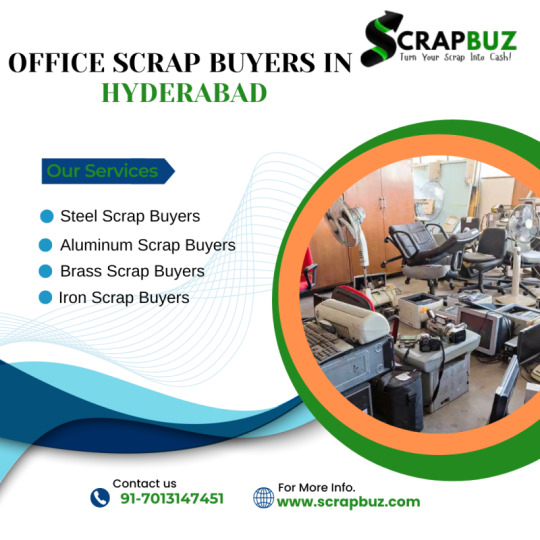
The kinds of office scrap that buyers typically purchase include:
1. Office Furniture: This includes old desks, chairs, cabinets, file holders, and conference tables. Scrap buyers can recycle metal components and refurbish wooden furniture for resale.
2. Office Electronics: Items like old computers, printers, fax machines, and photocopiers are commonly sold to office scrap buyers in Hyderabad. These items contain valuable metals like copper, silver, and aluminum, which can be extracted and reused.
3. Old Files and Documents: Though not a traditional form of scrap, old office documents and files are often sold for paper recycling. Some scrap buyers also provide shredding services to ensure sensitive information is disposed of securely.
4. Office Supplies: From unused stationery to old electrical components (such as light fixtures and wires), office scrap buyers also deal with miscellaneous items that are no longer of use.
Why Sell to Furniture and Office Scrap Buyers in Hyderabad?
Selling your old furniture and office scrap to buyers in Hyderabad offers several advantages:
1. Eco-Friendly Disposal: Instead of dumping your unwanted items in landfills, scrap buyers ensure that your materials are recycled, repurposed, or disposed of responsibly. This helps in minimizing environmental harm.
2. Monetary Benefits: Many scrap buyers offer cash for old furniture and office equipment. While you might not get top dollar for every item, it is still a great way to earn some money while clearing out space.
3. Convenience: Hiring scrap buyers in Hyderabad means you don’t have to worry about transporting your old furniture or equipment to recycling centers. The buyers will usually pick up the items from your location.
4. Space Saving: Whether you are downsizing your office or renovating your home, selling scrap furniture clears up valuable space and makes way for new and improved items.
5. Professional Services: Established scrap buyers have experience and know-how in handling a wide variety of materials, ensuring that your unwanted items are properly sorted and disposed of.
How to Find Reliable Scrap Buyers in Hyderabad?
Finding trustworthy old furniture scrap buyers and office scrap buyers is essential for ensuring that the process is smooth and environmentally responsible. Here are some tips to find the right buyer:
• Do Research: Check online reviews, ask for recommendations, and verify the reputation of scrap buyers in your area.
• Get Multiple Quotes: To ensure you’re getting a fair price, consider getting quotes from multiple buyers.
• Check for Eco-Friendly Practices: Make sure the buyers you choose follow environmentally friendly disposal methods and are licensed to handle scrap materials.
• Ensure Pickup Services: Many scrap buyers offer free pickup services, saving you the hassle of transporting items yourself.
Conclusion
In Hyderabad, old furniture scrap buyers and office scrap buyers provide an essential service that helps both individuals and businesses clear out unwanted items while contributing to sustainability. By choosing the right scrap buyer, you can not only make some money but also ensure that your items are disposed of responsibly. Whether you're cleaning out your home or clearing out an office space, scrap buyers in Hyderabad offer a convenient, eco-friendly solution to your needs.
0 notes
Text
BASF to showcase the sustainable future of plastics at K 2025

As the world’s leading trade fair for plastics and rubber returns to Düsseldorf this October 8th to 15th, BASF is again on board – just as it has been since the very first K-Fair in 1952.
“This year, we manifest our commitment to the plastics industry, and we continue our commitment to sustainability and innovation through our global campaign, #OurPlasticsJourney. More than just a tagline, it reflects our ambition to transform the plastics industry. This journey takes time, but the destination is clear: a circular economy of plastics,” emphasizes Martin Jung, President of BASF Performance Materials.
At the K-Preview press conference on June 17, BASF has unveiled a first glimpse of what visitors can expect at K 2025: innovative applications tailored to customers’ needs and showcasing real progress in circularity across various businesses and industries.
A product portfolio evolving toward a lower carbon footprint
At K 2022, BASF introduced its LowPCF and ZeroPCF portfolios as solutions to reduce the Product Carbon Footprint (PCF) by a minimum of 30%, through the use of renewable electricity, low-emission steam and renewable raw materials, in a mass balance approach. A current example for a ZeroPCF product innovation is VAUDE’s bike bag using Ultramid ZeroPCF, the first polyamide 6 in the industry to achieve a CO2 footprint of net zero.
Building on this, BASF has now launched a reduced PCF product range, rPCF, aimed at PCF improvements using renewable electricity and steam alongside the production process. The offering is now available in BASF’s Engineering Plastics and Thermoplastic Polyurethanes sustainability toolbox. It follows BASF’s achievement of completely switching all its European Performance Materials plants to renewable electricity powered by solar and wind energy. “With rPCF, we are giving customers flexibility to customize their products’ carbon footprint by opting for renewable energies in our production process. This is a logical next step in both their green transformation and ours,” adds Alexander Weiser, Senior Vice President, Head of BASF Performance Materials Europe.
Make becomes circular
While technology and processes are major levers of transformation, the use of alternative raw materials is equally essential. At K 2025, BASF will showcase products for which fossil resources are replaced with renewable feedstock at the beginning of the production process using the Biomass Balance approach. This helps reducing the carbon footprint of:
Siemens circuit breaker SIRIUS 3RV2: Ultramid BMB and Ultradur BMB
Certified compostable and soil-biodegradable biopolymers: ecovio and ecoflex BMB
ZARA bodysuit: Ultramid BMB
Additionally, BASF replaces fossil resources with feedstock from the chemical recycling of plastic waste in a mass balance approach for its Ccycled portfolio:
KASK safety helmet: Neopor Ccycled
Oysho sports leggings: Ultramid Ccycled
Transformation is not only about materials, but also about data. As the industry moves toward greater transparency and accountability, digital tools become essential to enable and accelerate the green transformation. To support this, BASF offers the PACIFIC app that provides standardization and interoperability in PCF data exchanges of plastic materials. Designed for ease of use, the PACIFIC app is seeing growing adoption across stakeholders in the value chain.
Use of plastics’ strengths
Plastics bring unique benefits to many applications that often extend their lifespan. This is particularly important for future technologies, such as the production of green hydrogen. For example, Ultrason S3010 (PSU: polysulfone) enables the production of larger, more robust and durable parts like frames in stacks for alkaline electrolyzers developed by Stargate Hydrogen.
In high-performance household appliances like the latest Thermomix by Vorwerk Elektrowerke, BASF’s engineering plastics, Computer-Aided Engineering (CAE), and testing capabilities support complex applications. Several parts are made of either Ultramid Advanced N (PPA: polyphthalamide) or Ultramid A (PA66: polyamide 66), selected for their high temperature stability and mechanical strength respectively.
In the eMobility sector, BASF has developed a next-generation battery demonstrator featuring advanced plastic material solutions to enhance lightweighting, thermal management, safety and performance.
Recycle is the new Make
As part of its commitment to a circular plastics economy, BASF is scaling up complementary recycling technologies to give waste a second life. Across various industries – packaging, furniture, appliances, textiles and vehicles – new solutions demonstrate how recycling becomes an engine of innovation.
To support efficient recycling processes, BASF subsidiary trinamiX provides a handheld tool for fast and reliable identification of different plastic and textile types. The trinamiX Mobile NIR Spectroscopy Solution facilitates cleaner sorting and improved recycling outcomes.
For paper-based food packaging, BASF extends the end-of-life options to organic recycling. Its tailored certified home and industrial compostable ecovio allows coating on paper food articles to achieve necessary barrier properties, especially for liquid and fatty ingredients.
As a leader in the polyurethanes (PU) business for more than 60 years, BASF is committed to demonstrating PU’s versatility and recyclability:
Together with its long-standing partner Vitra, BASF is showcasing the world’s first economically recyclable flexible foam for furniture.
In collaboration with Krauss Maffei, Rampf and Liebherr, BASF is also developing an efficient chemical recycling process to return polyurethane to the same material cycle. In a stable, continuous industrial depolymerization process, recycled polyols are produced, which can be used to manufacture new PU rigid foams as insulation material in refrigerators. By using post- consumer waste from end-of-life refrigerators as feedstock, the consumption of fossil resources can be significantly reduced.
Thermoplastic polyurethanes (TPU) also enter the circular economy: the new Elastollan RC grades include up to 100% recycled content with close to virgin performance by re-using post-industrial and post-consumer TPU waste.
With loopamid, BASF has developed an innovative solution to improve circularity in the fashion industry and recycle post-industrial and post-consumer polyamide 6 textile waste over multiple times.
Finally, BASF is advancing numerous projects in the recycling of automotive plastics via mechanical recycling, solvent based recycling, depolymerization and high temperature recycling such as gasification.
Join the conversation
BASF’s booth at K 2025 will also host live sessions such as #OurPlasticsDialogues — bringing together industry voices, partners, and customers to explore challenges and opportunities ahead.
This year’s K-Fair theme, “The Power of Plastics!”, aligns perfectly with BASF’s vision to lead purposeful transformation across the plastics value chain.
For over seven decades, BASF’s booth at K has been a central hub for materials, innovations and co-creations and a platform for personal exchange. This year, BASF will be present with six different teams: Performance Materials, Monomers, Styrenic Foams, Plasticizers, Plastic Additives and trinamiX.
0 notes
Text
Stringent EPR Rules Are Now Becoming Opportunities: Deepak Mishra
New Delhi: Plastic is no longer just an environmental challenge—it is increasingly becoming a vehicle for economic and technological opportunity. Speaking at the inaugural session of the 2nd Global Conference on Plastic Recycling and Sustainability (GCPRS) held at Bharat Mandapam, Pragati Maidan, Shri Deepak Mishra, Joint Secretary, Ministry of Chemicals & Petrochemicals and Fertilizers, said…
0 notes